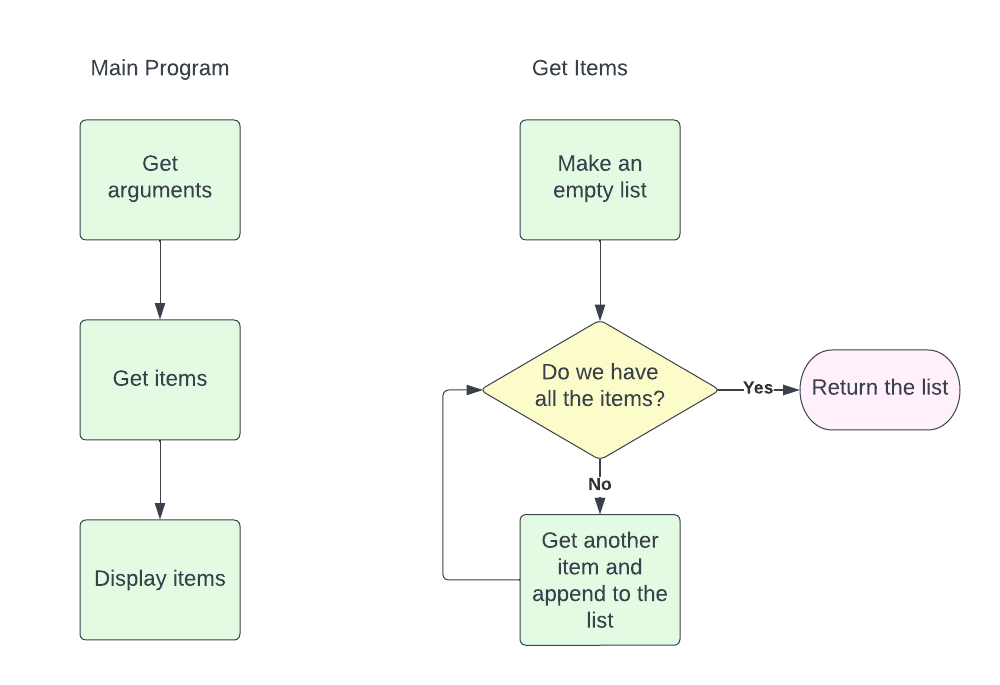To start this guide, download this zip file.
Program arguments
When we run a Python program from the command line, we can give it arguments. Suppose you want a program called “repeat.py” to print “wow” 10 times. You might run it from the terminal like this:
python repeat.py wow 10This will run the program in repeat.py and give it these arguments — wow
and 10. This program could then print “wow” 10 times.
argv
To get the arguments into your program, Python puts them into a list called
argv. To use argv, you have to:
import sysThen you can get the arguments in sys.argv:
import sys
if __name__ == '__main__':
print("Your arguments were:")
print(sys.argv)In the zip file for this guide you can find a program called arg_demo.py. If
you download the zip file and put it in your cs110 directory, then you can
open a terminal and run it with:
cd arguments
python arg_demo.py first second thirdthen this will print:
Your arguments were:
['arg_demo.py', 'first', 'second', 'third']Notice how the first argument in the list is the name of the program. Then the rest of the arguments come after that.
Accessing individual arguments
Let’s talk about how a Python program gets access to these arguments. Remember,
sys.argv is a list. We can number all of the items in the list starting from
zero:

With all lists, we can use indexing to select an item in the list. We do this with square brackets:
argument1 = sys.argv[1]
argument2 = sys.argv[2]If you look at hello.py you can see this in action:
import sys
if __name__ == '__main__':
print(f'Hello {sys.argv[1]}!')This program takes one argument — a name — and says “Hello {name}!“. You can see this by running:
python hello.py HarryYou will see:
python hello.py Harry
Hello Harry!If you try to run a program that is expecting an argument without any arguments, this causes an error:

This is because you tried to access item 1 from the sys.argv list, and there
is nothing at that index.
You can also run a program with too many arguments, but this won’t cause an error. The extra arguments will just be ignored. Try:
python hello.py Harry Ron HermioneAnother example is in repeat.py:
import sys
def repeat(text: str, number: int):
print(text * number)
if __name__ == '__main__':
text = sys.argv[1]
number = int(sys.argv[2])
repeat(text, number)Every argument in sys.argv is a string. This means we need to convert the
second argument into a number if we would like to use it as a number. Then we
call a function repeat(), which just uses text * number to repeat the string
that many times. It turns out that you can multiply a string by a number to
repeat it! So:

Arguments with spaces in them
What if you want to put spaces in an argument? You need to put quotes around the argument:
python repeat.py 'oh wow ' 10
oh wow oh wow oh wow oh wow oh wow oh wow oh wow oh wow oh wow oh wowThings
To practice these concepts, write a program that prompts a person to input things. After they are done, print the list of things.
The number of things to input and the prompt text should be specified on the command line as arguments. For example:
python things.py 3 Fruit
Fruit: apple
Fruit: pear
Fruit: banana
- apple
- pear
- bananaPlanning
You will find an empty file in things.py where you can write code for this.
Work with a friend to write this code. Try drawing a flow chart.

Here is an example flow chart:

The main program has three pieces:
- get the arguments (number of things, prompt)
- get the items
- display the items
To get the items, we can accumulate the items into a list:
- make an empty list
- while the list doesn’t have all the items
- get another item
- add it to the list
Writing code
Let’s write code for the main program:
def main(how_many: int, prompt: str):
items = get_items(how_many, prompt)
display_items(items)
if __name__ == "__main__":
how_many = int(sys.argv[1])
prompt = sys.argv[2]
main(how_many, prompt)Some important things to notice:
- we need to convert
how_manyinto an integer - we give both arguments to
main() main()calls the next two functions to do steps two and three in the flow chart.
Now we can write get_items():
def get_items(how_many: int, prompt: str) -> list[str]:
items = []
while len(items) < how_many:
item = input(prompt + ': ')
items.append(item)
return itemsWe keep looping as long as the length of the list is less than the desired
length, which is given in how_many. We use prompt to provide the prompt when
we call input(). Every time we get an item we append it to the list.
We can also write display_items():
def display_items(items: list[str]):
for item in items:
print(f'- {item}')You will need to run this program from the terminal. For example:
python things.py 5 'Your Major'
Your Major: Bioinformatics
Your Major: Mathematics
Your Major: Linguistics
Your Major: Vocal Performance
Your Major: History
- Bioinformatics
- Mathematics
- Linguistics
- Vocal Performance
- History